Table of contents
- Technology Superbike developments Performance, drivability, Euro 4
- Short valve timing, low valve overlap
- Valve control due to Euro 4
- Better drivability thanks to the new chassis
- Hysteresis = hysteria?
- Electronics from the Kawasaki are catching up
- Departures are much more likely this way
- No real racing ABS in sight
- Suzuki engine technology
- Low speed
- High speed
- Angle adjustment via centrifugal force
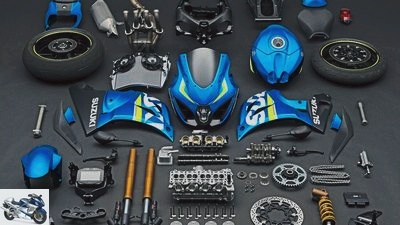
Suzuki
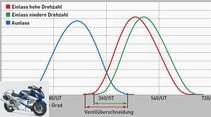
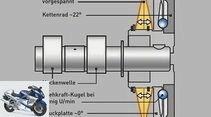

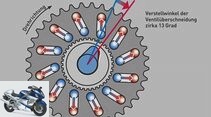
16 pictures

archive
1/16
Variable valve control Suzuki GSX-R 1000/2016.
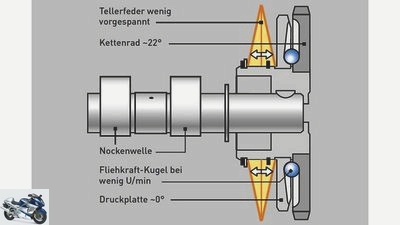
archive
2/16
Suzuki engine technology in detail: low speed.
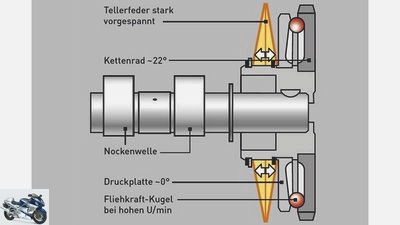
archive
3/16
Suzuki engine technology in detail: high speed.
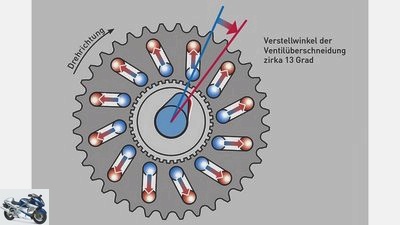
archive
4/16
Suzuki engine technology in detail: angle adjustment via centrifugal force.

Kawasaki
5/16
ZX-10R: The adjusting screw for the spring preload is located at the top of the fork plug. Hopefully there is a special key for this; if you approach it with a normal screwdriver, your head will be screwed up quickly.

Kawasaki
6/16
ZX-10R: Here again in detail the cut open sprue on the fork base, inside of which the damping is “made”. Each separately for the compression and extension movement and adjustable from the outside.
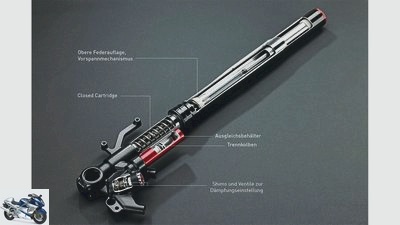
Kawasaki
7/16
ZX-10R: Cutaway models of forks are at least as difficult to read as a complicated maze. That is why the most important assemblies are specially designated here.
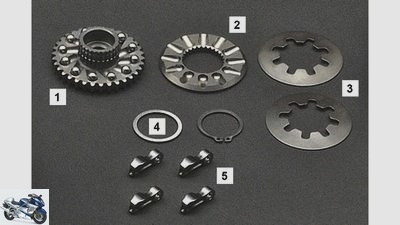
Suzuki
8/16
1: chain wheel, rotatably mounted on the camshafts and provided with inclined grooves; 2: pressure plate with radially arranged grooves; 3: Two disc springs that work against the centrifugal force; 4: thrust washer between camshaft and rotating sprocket; 5: Light single rocker arm for valve actuation.
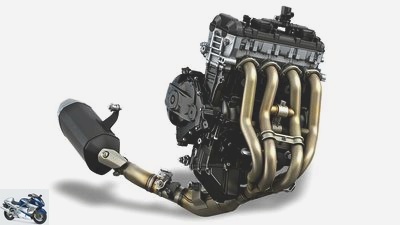
Suzuki
9/16
On the 2016 Suzuki engine, the electronically controlled flaps in the interference tubes between cylinders 1 and 4 as well as 2 and 3 guarantee more torque and maximum output. The system consists of ultra-light titanium tubes.
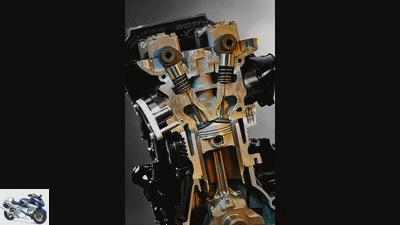
archive
10/16
When the valve overlaps at top dead center, the inlet and outlet valves are open for a brief moment. This causes good flow / filling at high speeds, but ensures poor exhaust gas values and increased consumption “down the road”.
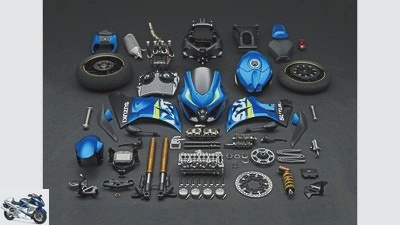
Suzuki
11/16
PS disassembled the 2016 GSX-R 1000 from Suzuki and carefully examined the technology.

Kawasaki
12/16
The appearance of the display has not changed on the new ZX-10R. Only the traction control display now goes up to level five. According to project manager Matsuda, the development of the engine, the chassis and the electronics has eaten up all development reserves. “We didn’t spend any money on cosmetic upgrades, not even a new dashboard. I put all resources into the lap times and the performance “.
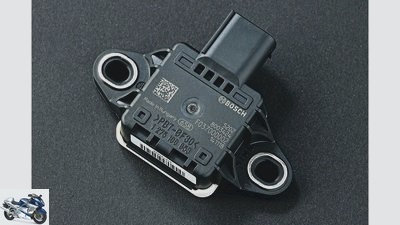
Kawasaki
13/16
The Bosch IMU sits on top of the airbox of the new Kawasaki ZX-10R and supplies the data for the control via the ECU.
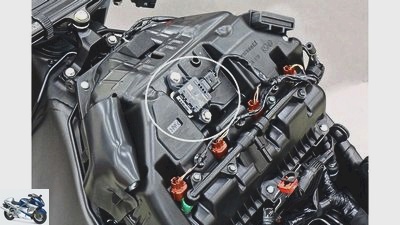
manufacturer
14/16
ZX-10R: The heart of the new Kawasaki control electronics, the so-called IMU (Inertial Measurement Unit), comes from Bosch. It is often referred to as a “five-axis” control unit. Kawasaki technicians, on the other hand, speak of a “six-axis” system in the new ZX-10R, but do not mean a geometric unit, but an additional control value, the yaw rate. This is recorded by an in-house system.

Kawasaki
15/16
ZX-10R: The new traction control can be varied and switched off using the toggle switch on the left handlebar.

manufacturer
16/16
The prototype: TTX fork from Ohlins. The expansion tanks are not absolutely necessary for this technology, the technicians also use internal rubber tanks in motocross forks. External containers take up more space, but serve as an additional cooling surface for the part-time job. Because the Ohlins technicians have accommodated the damping system and the expansion tank in one sprue, their fork looks more elegant.
counselor
technology & future
Technology Superbike developments
Technology Superbike developments
Performance, drivability, Euro 4
Content of
This year Suzuki and Kawasaki are getting ready to shake up the superbike world with their new bikes. There is also new technology in the house, which PS has taken a closer look at.
Werner Koch, Tobias Munchinger, Ralf Schneider
01/12/2016
The hunt for BMW continues. 2016 want Suzuki and Kawasaki the benchmark from Bavaria to the Lederhose and have come up with some ideas. This includes the drivability of the new superbikes as well as the sheer power output of 200 hp plus. However, manufacturers must also incorporate the signs of the times into their development, and that includes Euro 4, for example, with strict emissions standards. In order for everything to fit in the end, a few new technical tricks were obviously required, which we will shed a little light on here.
Buy complete article

Technology Superbike developments
Performance, drivability, Euro 4
8 pages) as PDF
€ 2.00
Buy now
It starts with the four-cylinder screamer from Suzuki. In order to achieve the highest possible degree of filling and thus a powerful torque and maximum output, the valves of a four-stroke high-performance engine should be open as long as possible. On the other hand, the engine must respond precisely and cleanly to the throttle command and run smoothly and smoothly in the lower partial load operation, i.e. with the throttle grip opened very slightly. That is why the engine designers are looking for the best compromise and in the case of the new Suzuki GSX-R 1000 for mechanical solutions to combine power and smooth running.
Short valve timing, low valve overlap
In addition to the durability (jerk-free actuation, the lowest possible acceleration and surface pressure), the engine characteristics as well as the exhaust gas and consumption values can also be massively influenced via the valve timing. As a rule of thumb, short valve timing and low valve overlap generate a wide torque range with low consumption. Long control times, large valve lifts and long overlaps, on the other hand, guarantee high peak performance with increased consumption and limited suitability for everyday use. As a result of the open gas exchange (valve overlap at top dead center), more or less fresh gas escapes into the exhaust, and the toxic hydrocarbon compounds are released into the environment. Especially during a cold start, as well as at low engine speeds and low load (little gas), the performance-enhancing overlap can impair the smooth running of the engine.
And so Suzuki is regulating the gas change in the upcoming GSX-R 1000 in line with the trend using the variable valve control technology that is common in automotive engineering. In this case it is a so-called phase adjustment in order to shorten the overlap at low speeds. The actual control times, i.e. the length of the valve opening measured in crankshaft degrees, are not affected. You just shift the beginning and the end of the control times to the same extent (phase shift). The Suzuki technicians currently do not want to give out a precise description of the new technology or even timing or a performance diagram, and so our information is based on the analysis of the components shown, hypotheses and empirical values.
Valve control due to Euro 4
One reason for the new valve control of the GSX-R 1000 is likely to be found in the future, tightened Euro 4 emissions regulations. Especially since Suzuki does not want to be left behind in the arms race. 200 hp plus is a must if you don’t want to lose touch with the competition from Aprilia, BMW, Ducati and Yamaha.
In the Suzuki engine, the centrifugal adjustment only regulates the phase shift on the intake camshaft. The opening time is shifted backwards by around 13 degrees at low engine speeds. With the effect that the fresh gases only flow in when the outlet valve is almost completely closed. This prevents some of the fresh gases from disappearing unused through the outlet valve. If the speed increases, the centrifugal adjustment rotates the intake cams steplessly in the direction of an earlier opening time, which means more valve overlap. PS assumes that the phase shift ends at around 5000 rpm and that the cams ensure maximum power and torque from this speed with the optimal overlap. If the speed decreases again, the overlap is also reduced. This technology is the first of its kind in a superbike.
In contrast, the so-called indirect valve control with rocker arms instead of the bucket tappets installed so far, which is referred to as direct valve actuation, is no longer entirely new. In addition to Suzuki, BMW and KTM also use this technology. And it’s not really new for Suzuki either, because it was already used in various GSX-R engines from the 80s and 90s. In contrast to the designs at that time, the current components are dramatically lighter and very robust thanks to an extremely wear-resistant and low-friction DLC coating (diamond like carbon).
Better drivability thanks to the new chassis
The valve control via rocker arm builds the sum of the oscillating components lighter than in comparable bucket tappet engines. Small disadvantage: The circular movement of the rocker arm on the valve stem creates a transverse force there, which entangles the valve in its guide and thus increases wear.
Like Kawasaki with the new ZX-10R, Suzuki will use a newly developed Showa fork in the next GSX-R 1000. It was presented under the difficult-to-understand designation “Balance free front fork” back in November 2014. It is a symmetrically constructed fork on which the reservoirs are the first to be noticed. As with the previously very exclusive racing shock absorbers, they contain a nitrogen filling that pressurizes the oil filling via a separating piston. An important step in striving for a uniform, reproducible damping effect.
Since the invention of oil damping for spring movements, the controlled flow of damper oil has been the central issue. It would be ideal if the damper components – hydraulic pistons, shim packs and valves – had an even and laminar flow of oil through them. So without it forming eddies and small cavities (cavitation) or uncontrolled narrowing of the free cross-section at the edges. This should be ensured at widely differing flow velocities and in a wide temperature range. Also, no air should get into the oil, which forms bubbles due to constant slight spring movements, shocks and vibrations. Damper oil, which has been foamed up by air or cavitation bubbles, causes the change between the damping effect and its complete collapse in a barely comprehensible rapid sequence. On, off, on, off, on, off.
Hysteresis = hysteria?
It is easy to imagine that the entire suspension system of a motorcycle, including the wheels and tires, no longer follows the course of the bumps, but a real chaos of disruptive influences. Quite apart from the fact that the reaction to shocks in the roadway always takes place with more or less delay, in the technical term hysteresis, because of the inertia, the mechanical friction and, last but not least, the hydraulic damping effect itself.
Anyone who connects this term with hysteria is wrong in the sense of the word meaning, but has found a very apt description for an overstrained damping system: It reacts hysterically to a multitude of overlapping impulses. When cornering, this usually manifests itself in the uncontrollable, high-frequency trampling of the affected wheel, the so-called “chattering”. Depending on the driving situation, however, far more unpleasant consequences of damping hysteria can occur. “Wildly pumping rear end, bottoming out, that causes you all kinds of trouble that you don’t need,” summarizes a suspension specialist.
In addition to the gas pressure, which counteracts the foaming of the oil in the new Showa fork, the closed damper cartridge should also contribute to the even flow of oil. Following the example of the TTX dampers and forks from Ohlins, the damper cartridge on the Showa fork is encased in a second tube – TTX stands for “Twin-Tube-Technology”.
Between the two pipes, the oil, which is displaced when the spring moves, sometimes in one direction, sometimes in the other, flows in a closed circuit. It no longer comes into contact with air. And just like with the TTX system, a simple piston works in the cartridge that only pushes the oil back and forth. The damper characteristics of the Showa fork are determined in a second side branch: In the sprue, which contains the two damper pistons with shims and the adjustment mechanism separately for compression and rebound damping.
Electronics from the Kawasaki are catching up
Little is known about the electronics of the Suzuki. It looks like there will be two GSX-R 1000 models, whereby an R version would have to have all the latest helpers such as traction, launch and wheelie controls, etc., especially for the electronics with a corresponding price difference to the base.
More has become known at Kawasaki, because an Australian test driver was able to set the spurs on the new ZX-10R in the run-up to the international press presentation. The experienced man praises the superbike in the highest tones. His quote “I don’t know of any series sports motorcycle that comes closer to a World Cup machine than this one” is in circulation. The colleague from Down Under was particularly impressed by the interaction between mechanics and electronics.
Yoshimoto Matsuda, project manager of the new superbike weapon, revealed to PS how Kawasaki’s approach to development in the area of driver assistance is concerned. Because, of course, a large part of the attention was given to them when the new motorcycle was being developed. Matsuda emphasizes that the electronics must primarily support the engine and chassis in increasing the mechanical grip of the machine. This is the only way to make a superbike fast in the end.
But only pilots who have complete confidence in the material are really fast pilots. That is why the traction control of the new tens was developed from a “reaction system”, as Matsuda calls it, to a “feedback system”. The ninja from 2011 already has a three-stage traction control. But this “reaction system” is now clearly lagging behind the slip controls of current superbikes. The S-KTRC (Sport Kawasaki Traction Control) of the old model monitors the wheel speeds and compares them with the throttle position, taking into account the current acceleration. If the tolerance values stored in the system are exceeded, power is reduced via the ignition.
Departures are much more likely this way
Compared to the latest systems in the BMW S 1000 RR, the Aprilia RSV4 or the Yamaha YZF-R1 with gyro sensor technology, this type of TC intervenes very roughly. Departures are much more likely this way. The Australian colleague, on the other hand, reports extremely inconspicuous control behavior with the new model, even in full throttle passages. So what happened The new ZX-10R now also features sensor technology from Bosch. The IMU (Inertial Measurement Unit) measures the acceleration along the longitudinal, transverse and vertical axes. In addition, the 40 gram component records roll and pitch rates. The yaw rate (lurching, drifting, breaking of the rear wheel), on the other hand, is calculated by the control unit using software written by Kawasaki itself. The manufacturer himself speaks of the “sixth axis” of its new TC. Kawasaki is taking a similar approach to Yamaha with the current R1: The hardware comes from the supplier, but the fine-tuning and one other control value are homemade.
Every five milliseconds, the system queries relevant data on the driving condition and regulates driving behavior via the ignition and the electronic throttle valves. It works in five stages and can be switched off. With that, Kawasaki should have at least reached the level of the competition.
No real racing ABS in sight
When it comes to ABS, Matsuda is much more conservative when it comes to his assessment of racing, especially with Kawasaki. “A sports motorcycle will never ride without a driver,” says the technician. “For an athlete, braking not only means stopping, but with the brake the driver also creates maneuverability with progressive and degressive control of the brake pressure and the initial braking. Therefore the driver is a fundamental part. He has to understand the limit of the tires: when turning, in the middle of the curve and at the exit. And he has to make maximum use of these possibilities, as well as those of the motorcycle. All of this in a complex racing situation – so I don’t think the current ABS technology is suitable for any form of racing, ”says Matsuda, referring to the current Kawasaki ZX-10R. This will have an ABS, which, unlike the previous tens, can be switched off. The system will certainly do a good job in one or the other rainy operation on the racetrack, but is not intended for real racing situations.
Nevertheless, a lot has happened on the new Kawasaki Superbike and there are some indications that the new ZX-10R, with its many improvements to electronics, engine and chassis, will again land a hit in the heart of the hobby racing scene. PS will take part in the test ride on the GP track in Sepang for issue 03/2016 at the end of January – then there will be the final resolution.
Suzuki engine technology
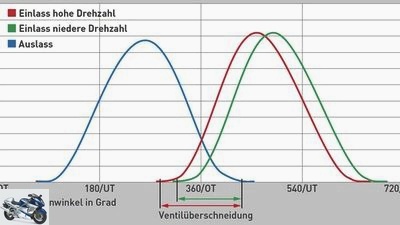
archive
Variable valve control Suzuki GSX-R 1000 model year 2016.
Despite the demand, Suzuki remains silent about the new technology. Apart from a few superficial information and photos, nothing could be learned about the variable valve control of the 2016 GSX-R 1000. So the technicians from the PS editorial team took care of the existing material and sorted the individual components into a functional sketch. The purely mechanical adjustment system of the Suzuki reduces the cost and material expenditure, but cannot be adapted to the load and speed range by electronic control, as is the case, for example, with Ducati’s hydraulic DVT system.
Low speed
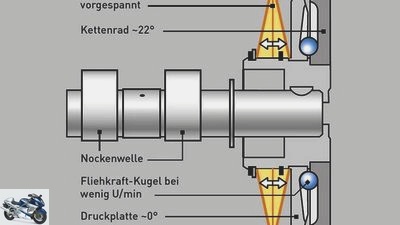
archive
Suzuki engine technology in detail: low speed.
The centrifugal force balls (blue) are held on the smaller diameter of the pressure plate by the conical shape of the grooves and the pressure of the disc springs (yellow). The twelve balls also establish the frictional connection between the inlet camshaft and the rotatably mounted sprocket.
High speed

archive
Suzuki engine technology in detail: high speed.
Due to the centrifugal force on higher tours, the balls (red) push themselves outwards against the force of the disc springs. In conjunction with the inclined grooves, the sprocket rotates around 13 degrees on the camshaft, which corresponds to 26 degrees of the crankshaft.
Angle adjustment via centrifugal force
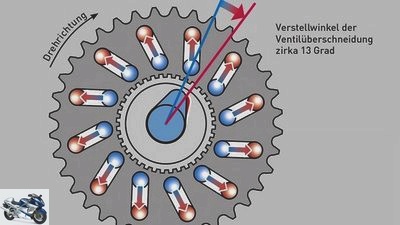
archive
Suzuki engine technology in detail: angle adjustment via centrifugal force.
A sophisticated mechanism consisting of centrifugal balls and the chain wheel with its inclined grooves results in an angle adjustment of around 13 degrees, measured on the camshaft. Since the balls also take over the power transmission between the chain wheel and the pressure plate, the balls are shifted outwards at higher speeds by this additional force.
Related articles
-
Superbike World Championship technology
2Snap accesories landing gear & Spring elements Superbike World Championship technology Superbike World Championship technology Ohlins chassis…
-
This is how the new super sports technology works
Suzuki 20th pictures Suzuki 1/20 The Suzuki GSX-R combines high tech with clever engineering. Suzuki 2/20 This centrifugal force mimic adjusts the timing…
-
Superbike World Championship: technology of the Aprilia and Ducati factory machines
motorcycles Superbike World Championship: Technology of the Aprilia and Ducati factory machines Superbike World Championship: Technology of the Aprilia…
-
Technology: BMW S 1000 RR engine in detail
BMW 13th pictures Artist 1/13 The on-board tool kit of the BMW almost ties in with old traditions. With the help of the nine-part set you can strip the…
-
manufacturer 12th pictures manufacturer 1/12 The trick with the pressure: intake tract and intake manifolds. 2snap 2/12 Two louvers on the MotoGP Honda….
-
Technology: exhaust gas cleaning
motorcycles Technology: exhaust gas cleaning Technology: exhaust gas cleaning Scourer How clean is the F 650 GS really, asked MOTORRAD in issue 10. Now…
-
Technology comparison of new supersport motorcycles 2015 – part 2
MOTORCYCLE 30th pictures manufacturer 1/30 Aprilia RSV4 RR. Aprilia is still quite stingy with pictures of the new RSV4 RR. manufacturer 2/30 Kawasaki…
-
Technology: suspension and chassis
fact accesories landing gear & Spring elements Technology: suspension and chassis Technology: suspension and chassis New trend: Big Piston Fork New trend…
-
MotoGP technology: valve trains
counselor workshop MotoGP technology: valve trains MotoGP technology: valve trains Sex offender Stoner? Traction control? Tire technology? Happiness? It…
-
BMW K model, new, for 2005: technology
MOTORCYCLE counselor technology & future BMW K model, new, for 2005: technology BMW K model, new, for 2005: technology The revealing Michael Pfeiffer…